40+ Fascinating Wedding Traditions From Across The Globe
Weddings are often a lavish celebration of the union of two people, and are often treated and organized as the most memorable day a couple can experience. But since you’re here, you’re probably more than aware that every culture and nation has its own rituals, traditions, and customs that the wedding party and the guests participate in. Some of these, however, are stranger than shoving cake into your soon-to-be-spouse’s face, and throwing the bridal bouquet towards the bridesmaids. Ranging from temporary tattoos to almost being crowned at your wedding, there are a lot of interesting rituals that make the wedding day special for both brides and grooms. Here are 45 traditions you wish you could witness with your own eyes!
Guatemala – Breaking a Bell
The wedding reception is to be hosted by the groom’s parents when it comes to weddings in Guatemala, and they’re given the freedom to celebrate the union of their son with their in-laws in whichever way or form they deem fit.
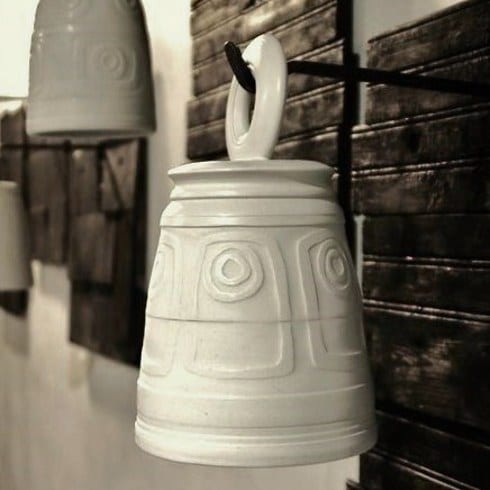
If you ever have the honor of witnessing a wedding with Guatemala traditions, don’t be too shocked if you see shards of ceramic fly across the guests. The groom’s mother shatters a white ceramic bell filled with flour and rice to indicate the arrival of the couple.
Lebanon – Zaffa Celebration
If you’ve ever attended a Lebanese wedding, you might have witnessed the musical procession, Zaffa, consisting of men playing drums, the bagpipes, and many belly dancers grooving to the loud beats. People from both sides of the happily married couple enjoy the celebration together.
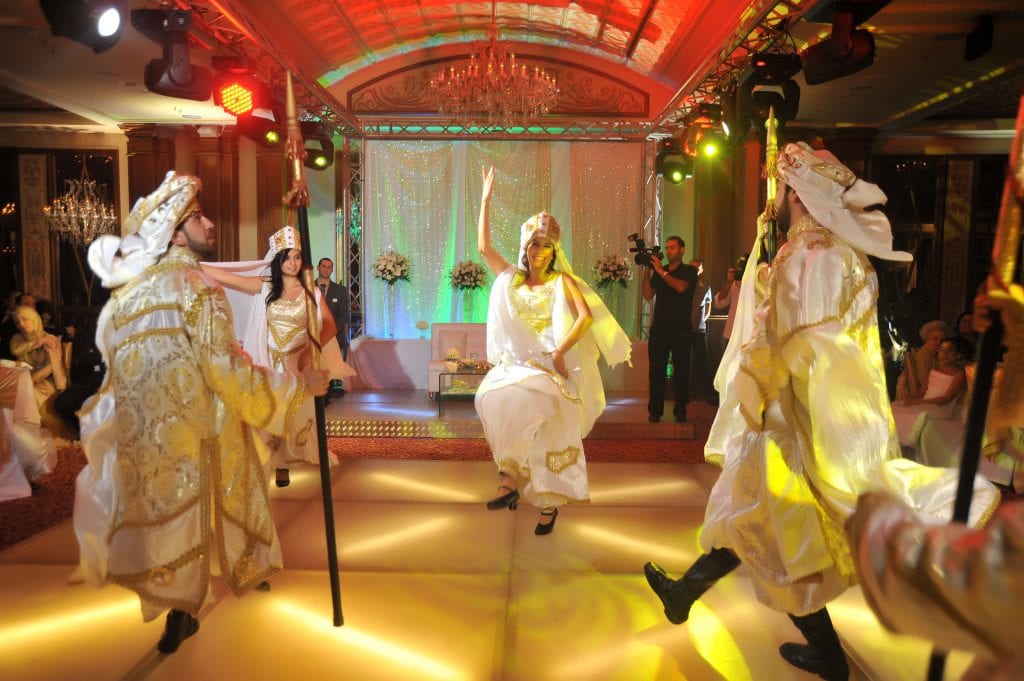
After the couple spends a long time with their loved ones and their well-wishers, the party then moves to the bride’s house according to tradition, where blessings and gratitude are exchanged for and by the newlywed couple. It sounds like a blast!
Scotland – Parade
If you like to get messy while you party, look no further than this Scotland wedding tradition! It is a well-known custom that the friends of the bride and groom take them away just a short while before the ceremony.

They cover the soon to be couple with anything and everything that they can lay their hands on: ash, feathers, mud, flour, and some even opt for eggs. The couple is then paraded through the town in an attempt to admonish evil spirits before the ceremony.
Mexico – Lasso
Mexican weddings often include a lasso as a part of a very specific tradition during the vows and ceremony. A lasso is best defined as a rope of rosary beads, and it often has flowers and other decorations woven together.
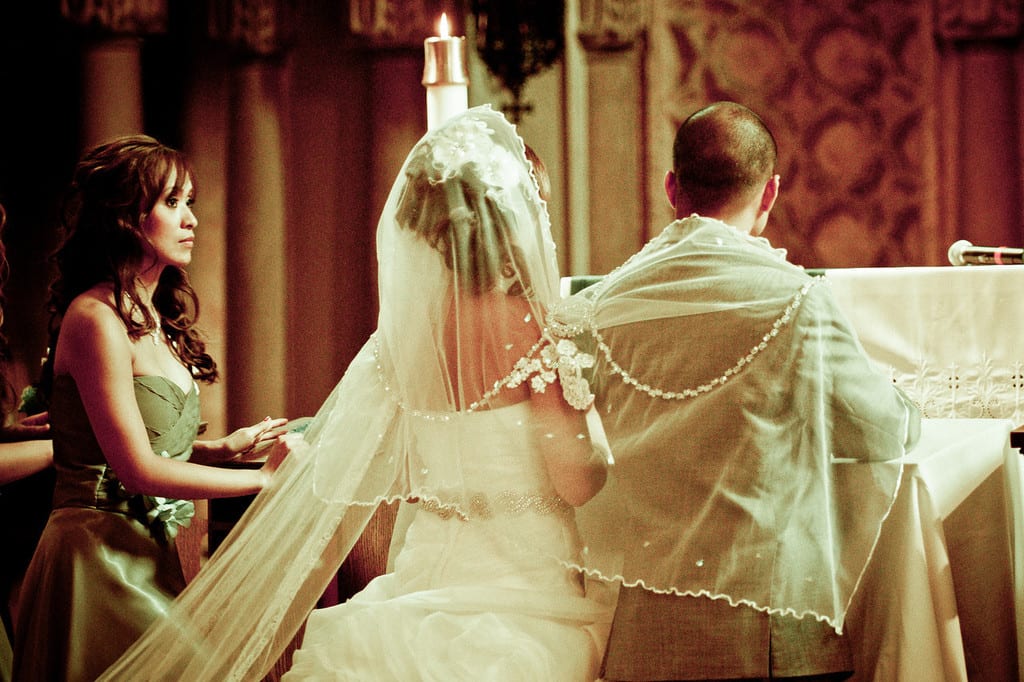
The lasso is wrapped around the couple during their wedding ceremony to form the symbol of infinity – it looks like a horizontal eight – around them. The shape signifies eternity, and is said to strengthen the bond and the marriage of the couple.
India – Tattoos
Henna, or more commonly known as Mehendi in India, is a plant-based paste that is applied to the hands, arms, and feet of the soon-to-be bride and her friends. This paste stains the hand with hand-drawn designs and can be scraped off to expose a brownish semi-permanent tattoo.
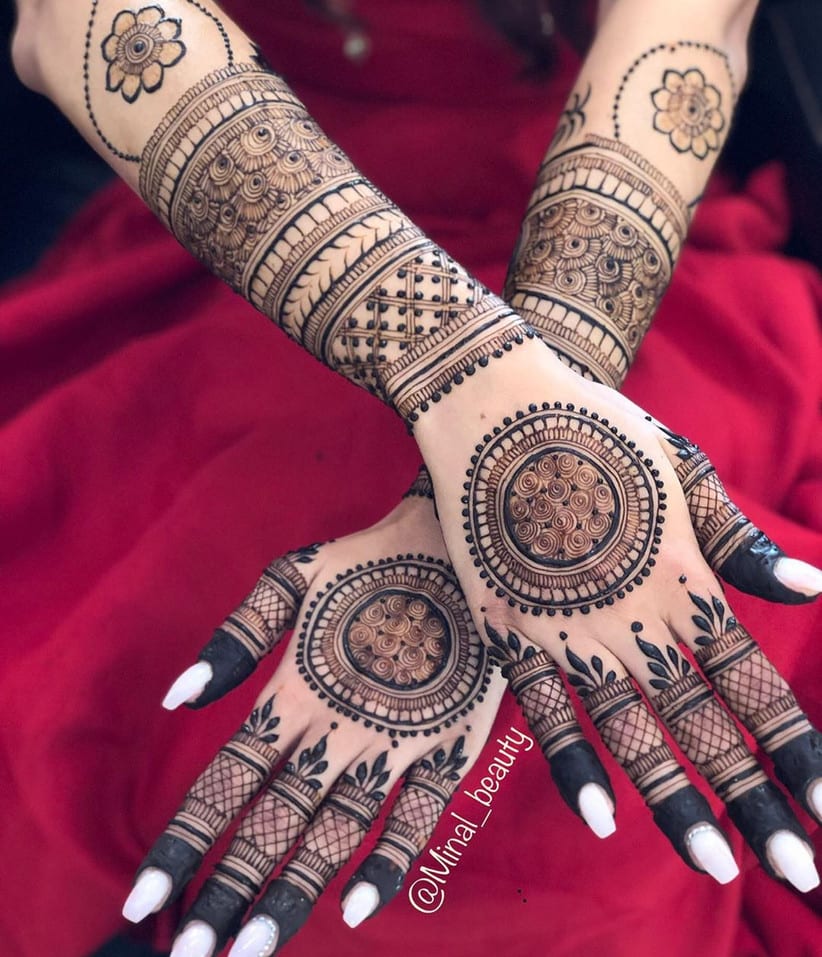
These designs can last on the skin anywhere between 5 days to 2 weeks, and have a pleasant, earthy aroma. The art of these designs usually is in touch with Indian tradition and history, and brides often get the name of their betrothed hidden in their tattoo for a quick name-spotting game.
China – Good Luck Woman
It is in line with traditional wedding ceremonies in China that the bride’s family hires a ‘good luck’ woman. This woman’s role is to accompany the bride to her new home with the husband, and ensure that everything runs smoothly.
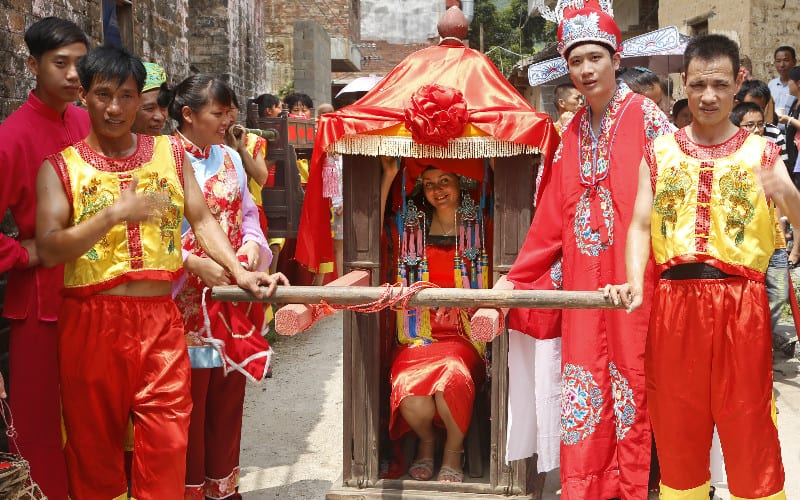
The vehicle this lady is given to travel in is sometimes a uniquely-decorated, and even luxurious, car. The custom is perhaps the most popular of the lot in China, and is something that is looked forward to by almost all attendees.
Russia – Bread Sharing
This was something we found almost surprising: one of the sweetest wedding ceremony traditions can be found in Russia! It involves only the bride and groom, and the couple has to share korovai, a special kind of bread made for their celebration.
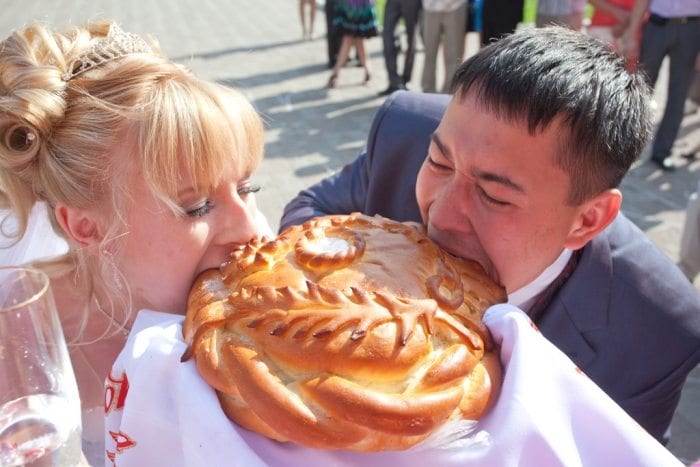
This bread is typically sweet to taste and is decorated with marks of wheat that symbolize faithfulness, love, and prosperity. The couple is expected to treat this like a fun game, attempting to eat the bread together without using their hands.
Czech Republic – Babies
The most popular tradition in weddings held in the Czech Republic is the placing of an infant in the arms of the couple. This is a way to bless them with healthy and prosperous fertility in their marriage, and is done prior to the ceremony.
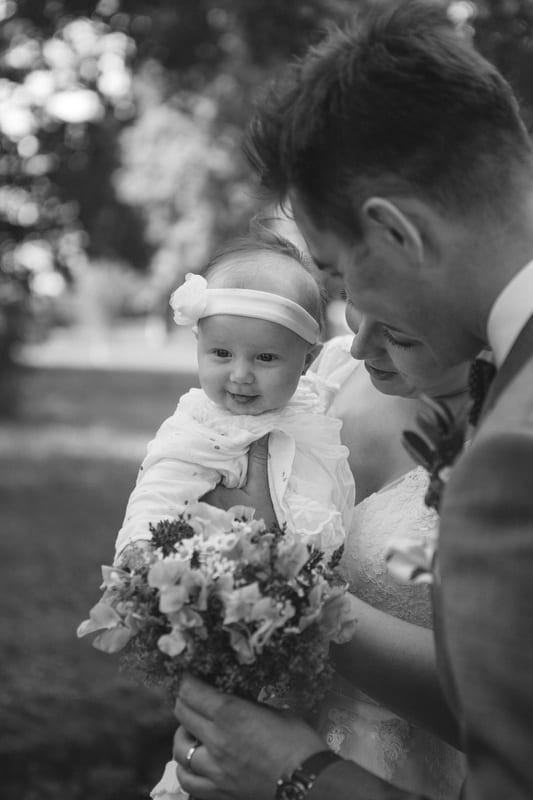
Once the ceremony is completed, the newlyweds are also showered with rice, lentils, and peas, as these are symbols of fertility. Child rearing is considered one of the most important duties of a married couple in this culture, and the blessings are met with gratitude.
France – Eating from the Toilet
A tradition that sounds all fun and games till you hear the crux of its details. French weddings definitely deserve to be on this list with one of the strangest customs we’ve come across yet! It seems like an innocent chocolate eating and champagne drinking ritual, but there’s more to it!

These treats – and other leftovers from the wedding – have to be consumed out of a used toilet bowl. Yes, we know – we gagged, too! The bowl is obviously cleaned before the food is placed in it, but we figure this is not a tradition you would participate in unless you’ve seen it growing up.
Wales – Bouquet
While the bridal flower bouquet is an important tradition participated in by many couples across the globe, the one practiced in Wales is slightly different. Less competitive, and definitely more personal in nature, the bouquet is pretty much shared by all the bridesmaids.

A cutting of myrtle — a herb that symbolizes love — is given to each of the bridesmaids. If the bridesmaid plants the cutting and successfully grows the sapling, it is believed that she will be the next to get married.
Greece – Grooming
While almost every culture requires that the bride and groom have sets of close friends and family as their companions during their wedding ceremonies, Greece takes the term ‘groomsman’ to a completely different – and a quite literal – level.

The best man is, essentially, made responsible for all grooming of the groom the day before the wedding ceremony. He has to shave the groom’s face carefully as a symbol of their bond, and takes the place of the designated barber.
India – Cursed
In parts of Hindu culture, the most popular religion in India, it is often believed that due to a miss-match in horoscope and time of birth, a woman can be cursed. Many believe that this curse acts on the marriage shortly after the ceremony and leaves the newlywed bride widowed.
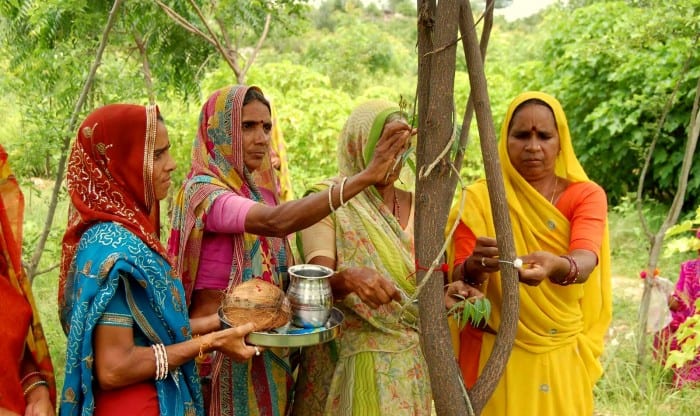
The most popular way to get rid of this curse is for the woman to first marry a tree and then cut it, in a way killing her first husband so that the curse doesn’t fall onto the human husband.
Norway – Crown
Norwegian weddings are beautiful, like all ceremonies, but they’re not lacking when it comes to traditional elements to make the day more memorable. One of these is the requirement that the bride has to wear a silver and gold crown during the vows!
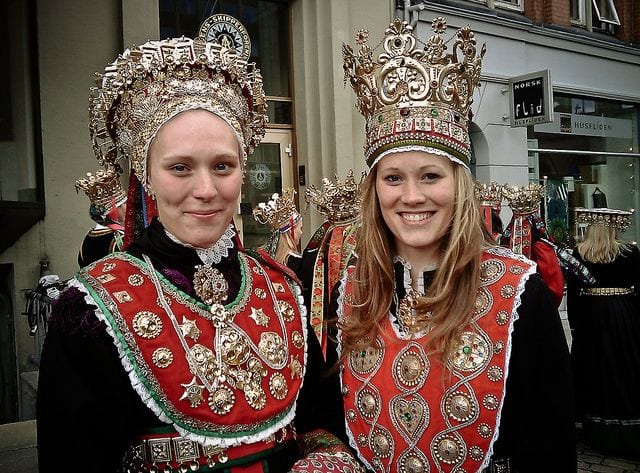
The crown has small elements and charms attached to it that sway with every little movement of the bride. This helps in creating a sound that people in the region and culture believe wards away evil spirits on the celebratory date.
Russia – Worth
In a tradition where the groom needs to prove that he is worthy of marrying the bride, this Russian custom requires the groom to visit his soon to be in-law’s house on the day of the wedding and pay his respects, while giving gifts.
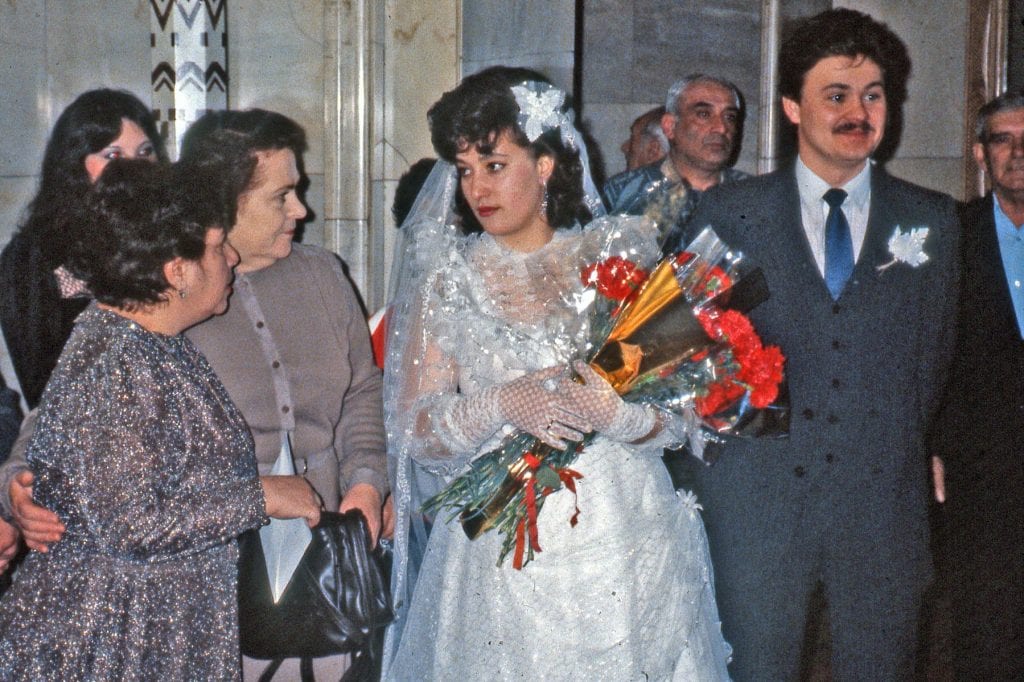
This is usually used as an opportunity for the groom to also display his singing and dancing talents till the time her parents tell him to stop. It is considered a more fun – and embarrassing – ritual that grooms happily uphold.
Turkey – Flag
If you’re ever a tourist in Turkey and see their national flag hoisted outside a resident’s home, don’t assume it’s for patriotism. It is a well known custom to hang the Turkish national flag outside the house of a groom.
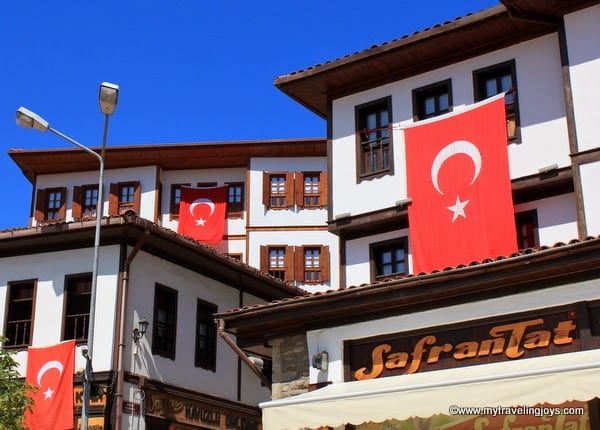
Some people also place nuts, vegetables, fruits, and mirrors close to their flag to indicate that the wedding ceremony and festivities have already begun. This announces to the world that their son, the groom, is officially “off the market!” Send in your congratulations respectfully.
Wales – Lovespoons
While the title may remind you of cuddling and spooning with your loved one, this interesting Wales wedding custom actually has to do with actual spoons! The lucky groom, and other men, have to carve out spoons from wood. This is new to us!
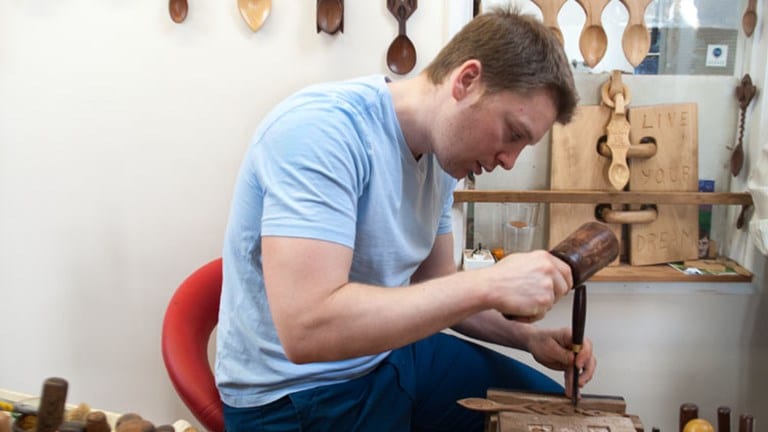
This sounds exhausting and laborious to be done during a celebration, but it is to show their affection for not only their wives and partners, but mothers and all the women who have made them who they are. The markings on the spoon can indicate how many children he wishes to have.
Romania – Abducting the Bride
This sounds terrifying to us, but we assume if you’ve grown up watching this happen, you’re ready for it. A wedding custom in Romania includes the guests of the ceremony whisking the bride away, and demand money or gifts from her groom for her return.
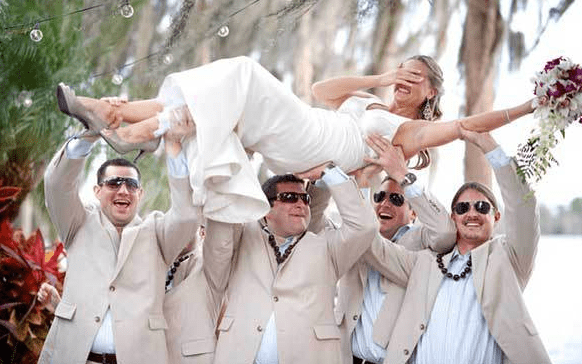
The guests take their participation seriously and play their role of kidnappers well by keeping the bride far away. They do take her somewhere she would like to be, of course. This is a fun tradition for everyone! The gifts are usually in the form of drinks or dares and challenges for the groom to complete.
Indonesia – Staying at Home
While being told to stay at home during the waves of Coronavirus has been traumatic in itself, this Indonesian wedding tradition emphasizes spending time together by making the lovely couple spend at least 3 days confined in a shared space.
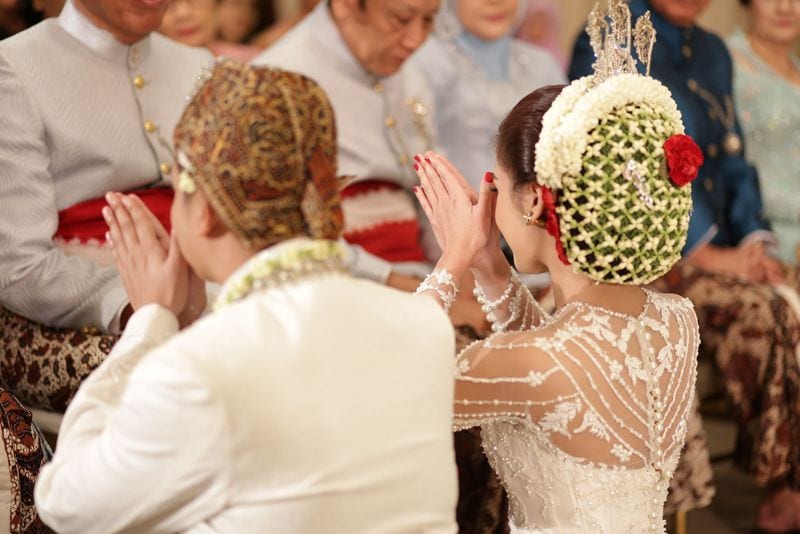
While the initial, and rather extreme, reason for this was to prevent the couple from using the bathroom, and instead spend all their time together, the crux of the custom is to strengthen their bond. It is believed to result in healthy babies as well.
Japan – White
Out of the many traditions in Japan, this might sound like the least strange to those of us who are accustomed to white weddings. In some Japanese, the bride is required to be dressed in all white, and this doesn’t mean just the dress.
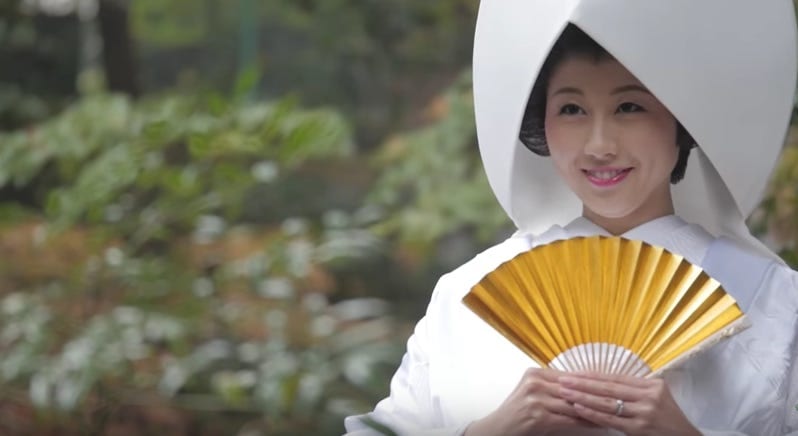
She has to be dressed in white cloth, white flowers, her makeup has to be white in color and tone, and she must have a white veil or a hood. This is considered to ward off jealousy during the ceremony.
Armenia – Spirits
While the goal of warding off evil spirits runs far and wide in the wedding customs across the world, Armenian weddings might be a step ahead. What they do in Armenia is balance flatbread on the couple’s shoulders while they get married.
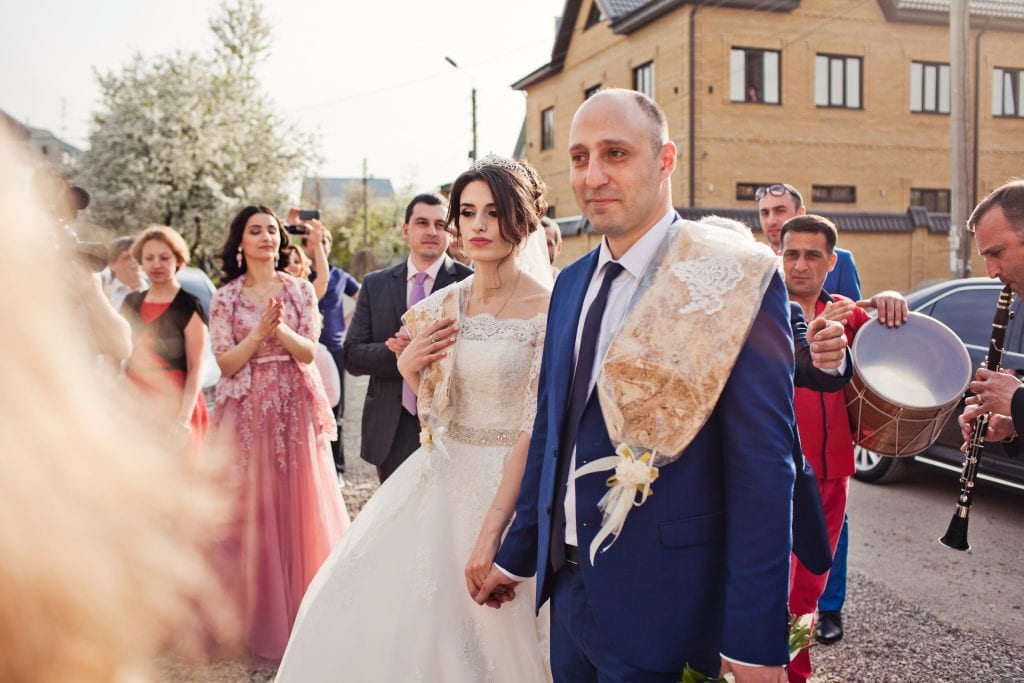
In addition to the bread balancing, at their wedding reception at the groom’s house, the couple has to break a large plate for good luck. And then they get served the bread with honey for the rest of the ceremony.
Venezuela – Sneaking Away
Treated like a game at the ceremony, in Venezuela the bride and groom are expected to make a plan to sneak away before the celebrations and the party are over. The aim is to leave before everyone else without getting caught.

Here is where it gets more interesting! The couple’s guests of course know about the custom, and it becomes a game to catch the couple sneaking away, or exposing their plan before the newlyweds can make a dash for it!
Peru – Wedding Cake
Almost all celebrations have cake for the guests who have a sweet tooth. In Peruvian weddings, there is a fun game involved for the beautiful bridesmaids! The cake comes with ribbons that are attached to charms, and one is a fake wedding ring!
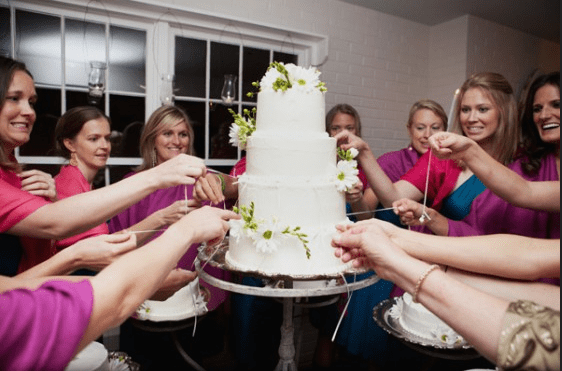
Each bridesmaid picks a ribbon and pulls at it, and whoever gets the fake wedding ring charm is said to be the next to get married. This is similar to the flower bouquet tradition, but we think it’s a lot sweeter.
Cuba – Money Pinning
We all know or have heard that Cubans know how to party, and that definitely shows in their weddings! One of the more expensive-sounding customs in their weddings is that of pinning money to the clothes of the happy couple.
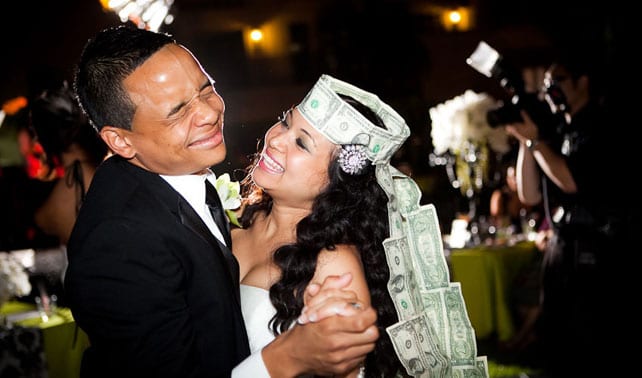
Any man who dances with the bride during the wedding reception is expected to pin some money to her dress, and this is a fun way to help the new couple comfortably pay for their wedding services, and their honeymoon!
Sweden – Kisses
In a tradition that we find cute, but some may find uncomfortable, anytime one half of the couple is absent, it allows for kisses to be exchanged with others! The ladies around the groom have the right to kiss the groom whenever his bride leaves the table or his side.

This extends to the men as well, and if the groom leaves his bride’s side, the male guests can kiss the bride. The aim is to establish boundaries, but also fun, so that jealousy is not an issue faced by the couple in the future.
Canada – Sibling Dance
Canadian weddings display yet another simple and sweet tradition where the elder siblings of the bride and groom have to perform a dance while wearing funky socks! While this tradition only applies to unmarried siblings, it is memorable for everyone.

But it isn’t just embarrassment that the siblings provide everyone. The better they perform, and the wilder, the more money the guests of the wedding party throw at them! This money is typically collected and given to the couple as a gift.
Germany – Polterabend
If you like breaking plates at weddings as a guest without worrying about cleaning up, a wedding in Germany might be for you! Newlyweds are required to, essentially, clean up piles of broken and shattered porcelain dishes broken during the ceremony.
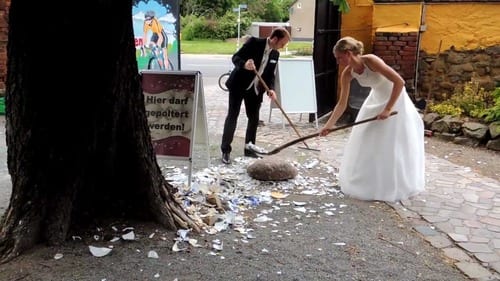
The plate breaking is encouraged to ward off evil spirits, and the clean up by the couple is to mark a sense of teamwork as their marriage begins. The mission is to learn that they can overcome any problem together.
Scotland – Secret Village
England made the act of getting married before turning 21 years old punishable by law centuries ago, but for some reason, this upset many people. With many trying to find loopholes to successfully running away with their beloved, a special town comes to the rescue.

The village called Gretna Green was a place where these age limits for marrying didn’t exist, and many young people eloped and went to that region to get married. This town still exists, and acts as a haven for those who have eloped!
Niger – Camel Dance
We’ve never heard of the camel dance before, but the West African country Niger includes it as a part of the community’s wedding rituals! This primarily consists of the newlywed couple performing a dance of sorts with a camel while in the desert.
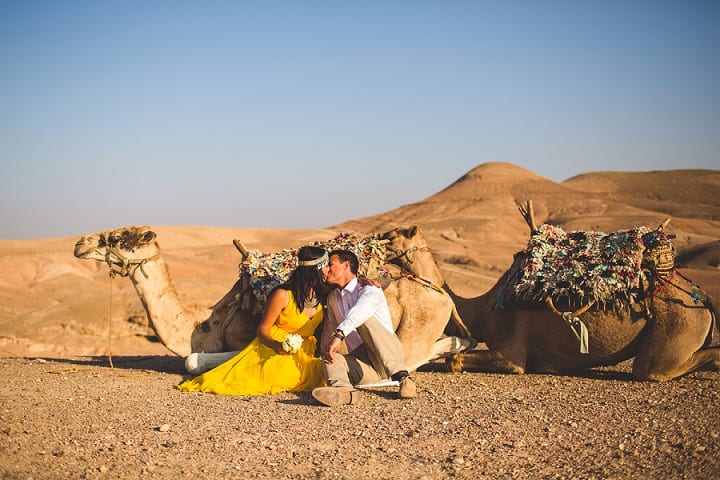
This dance is done with an adult camel to the beat of a drum, and the performance is enjoyed by all guests of the wedding. The camel is really the main performer, and only once the camel has stopped its dance can the ceremony continue.
Italy – The Surprise Party
This is not a common custom in Italian weddings, but the groom sometimes throws a surprise party for the bride outside her room window before the wedding day. This is an adorable act of love, as he serenades his soon to be wife.

What’s more, after the smooth singing and cute gestures, the group heads to a party with an extravagant and delicious menu, great music, and beloved company to enjoy and mark the celebration. This sounds like an amazing tradition to us!
Ireland – Dance
Ireland is known for its dance culture, and so we’re not surprised that it’s a big part of their wedding ceremony and celebrations! But as usual, there is a twist to the big wedding custom, and that involves the bride.
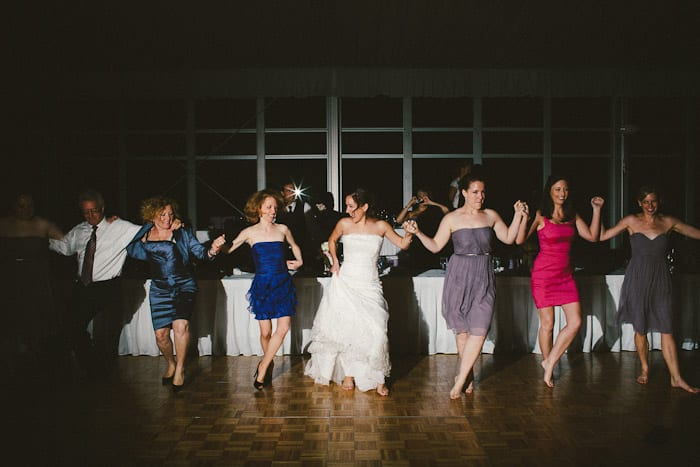
According to this tradition, the bride must keep one foot on the dance floor at all times. This is so that no evil spirits can sweep under her if both her feet are in the air, and drag her away.
Fiji – Whale’s Tooth
As is customary in many cultures, the groom has to request his bride’s father for her hand in marriage. However, in Fiji, this is not as straightforward, and a special gift has to be offered for the proposal to be considered.

The father of the bride has to be gifted a real whale’s tooth by the groom. We wonder where the father in law would keep the tooth, but this question is only relevant if he accepts the proposal and the wedding is on!
China – Crying
As with most wedding schedules and planning, things can be hectic. Ensuring that the bride and groom have the most fun and memorable day of their lives takes a lot of effort. But brides in China prepare and practice for one particular custom.
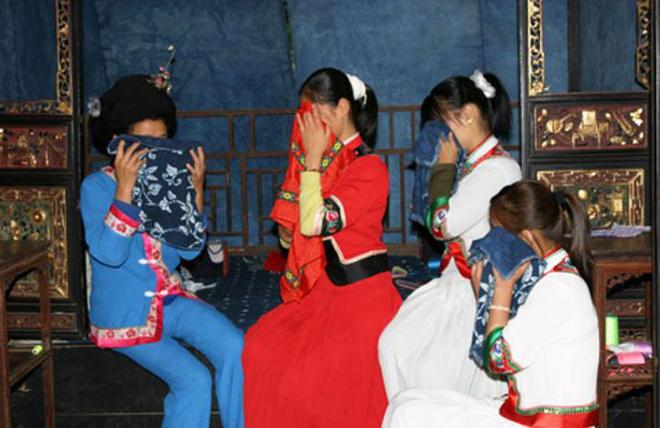
She practices how to cry for an hour every day a month before the wedding! Her mother and grandmother, along with cousins and friends, also join in on these practice sessions ten days before the wedding, so that the tears can pour out effortlessly on the big day!
South Korea – Falaka
Hands down, we found this to be one of the strangest wedding traditions on this list! In South Korea, it is common for the groom to be laid down while his friends and family beat his feet in something called the Falaka ceremony.
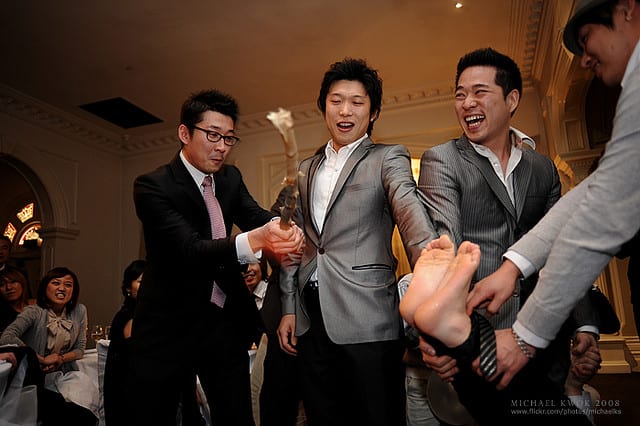
The beatings usually take place with sticks or dried fish, which just makes the whole experience far stranger than we had expected. The tradition carries with it a fun and innocent trivia game to make the groom focus on the quiz rather than the beating.
India – Joota Chuppai
Do you love treasure hunts? So do we! The Indian bride’s friends and family have a custom where they steal the groom and his guest’s shoes and hide them. They then ask for money and gifts before returning the shoes.
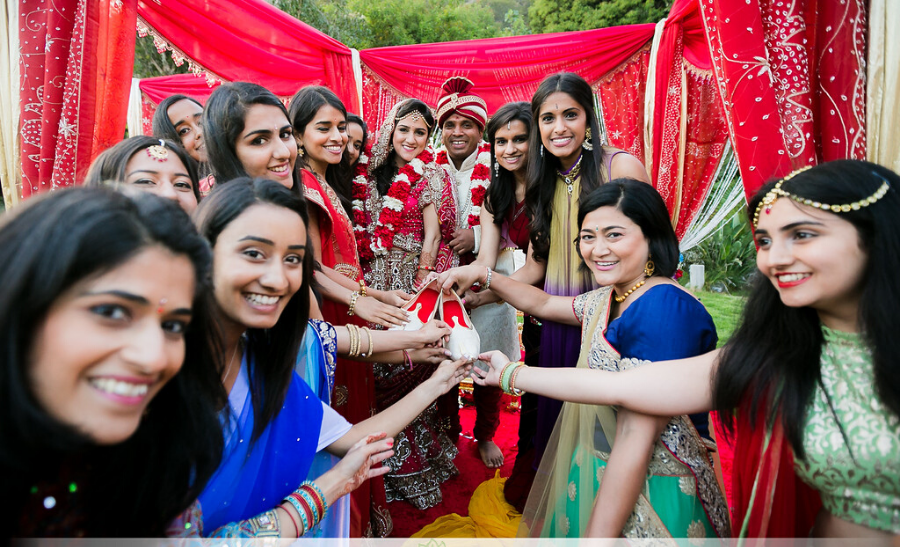
Because of how popular this tradition is, grooms are usually on the lookout for these thieves, but very rarely do the girls fail. The tradition brings with it laughter and a chance for the groom to display his generosity, while fighting for something of his.
Norway – Cakes
When we imagine a wedding cake, we picture a white, multi-tier, flowered, elegant cake. But in Norway, the wedding cakes look incredibly fun, and are nothing like the typical vanilla and chocolate cake at most weddings we’ve probably been to.
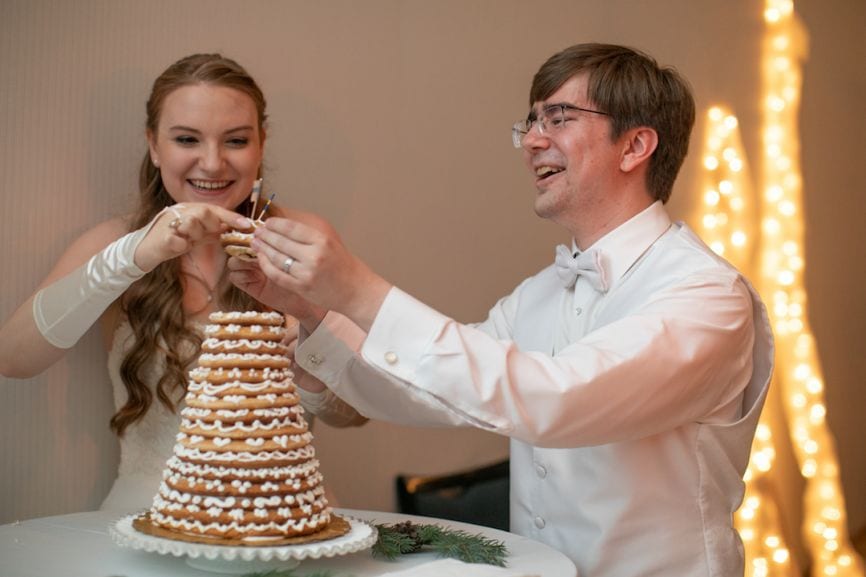
This delicious treat is called Kransekake, and appears like a tall stack of pancakes. It’s made of cake rings of iced almond and is shaped like a cone. According to custom, a bottle of wine should be placed at the core of the cake.
Spain – Ties
If you’re someone in sales, you might want to be a groomsman at a wedding in Spain! The friends and family of the groom have to cut the ties they’re wearing and sell scraps of them to the guests. The aim here is to raise money for the newlyweds!
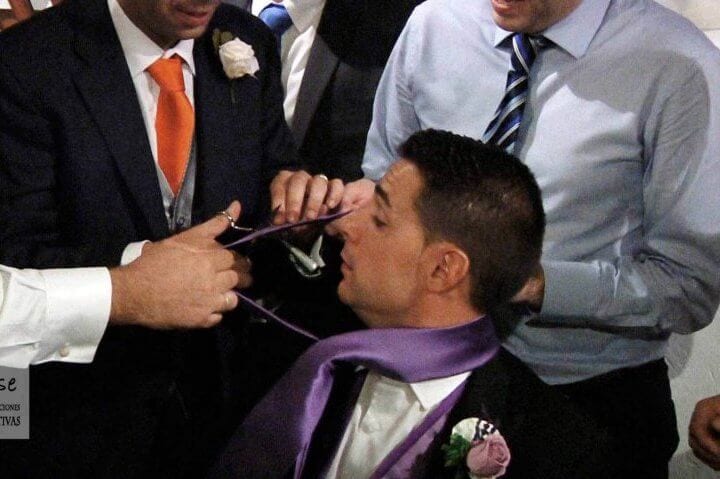
If the wedding expenses are large, the bride’s guests do the same and help the couple pay for the lavish services. But it must be remembered that this isn’t just about the money. It’s about the fact that true friendship will always surround the couple.
China – Bow and Arrow
China has been on this list a few times now, and we want to know more! One seemingly dangerous custom is that of the bow and arrow, wherein the groom aims and shoots an arrow at his own beloved bride.
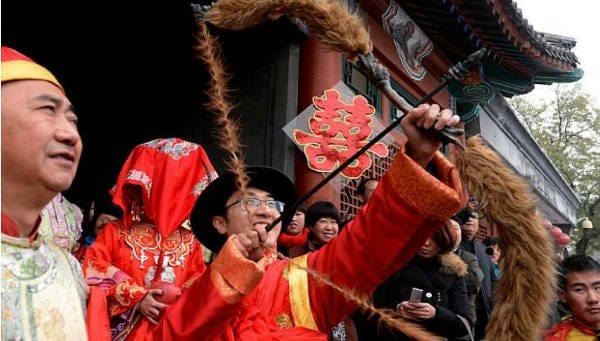
Wait! We forgot to mention they’re headless arrows, and do not ever cause injury! The act leads to the actual tradition, which is that of the groom collecting and breaking the arrows to show unity and strength in their love.
Congo – No Smiles
Most of us instinctively smile when a camera is pointed at us, unless we’re shy. But this wedding tradition from the Congo takes posing a different direction. Weddings are deemed to be the happiest day for some couples, and this tradition is an interesting take on it.
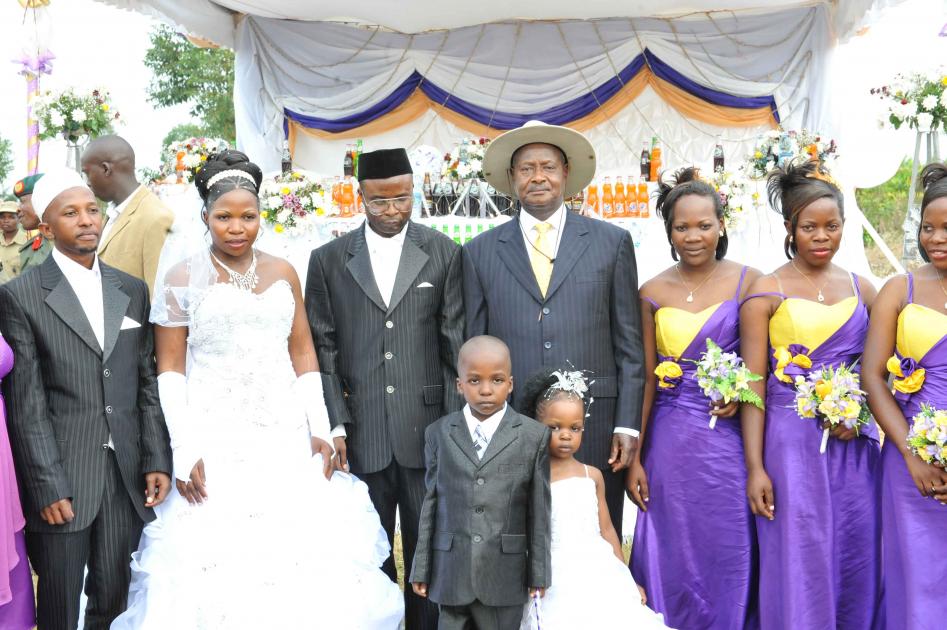
The couple and their guests have to refrain from smiling during the entire wedding day. If anyone is seen smiling, it is said that they are not serious about this union and it is as though the marriage is a joke to them.
Philippines – Doves
These pretty white birds are seen as the universal symbol for peace and harmony. Bearing that in mind, it is unsurprising that they are also a part of a beautiful and loving wedding tradition in the Philippines. We love this!

The newlywed couple have to release a pair of white doves into an open space after their vows and ceremony, before the celebration party can begin. They are supposed to release one female and one male bird, each symbolizing one half of the new couple.
Germany – Wood
After the ceremony, the bride and groom in Germany are expected to cut a log of wood together. This task is not made easy for the couple in any way. They’re usually presented with a thick and large log, and it’s tough to cut.
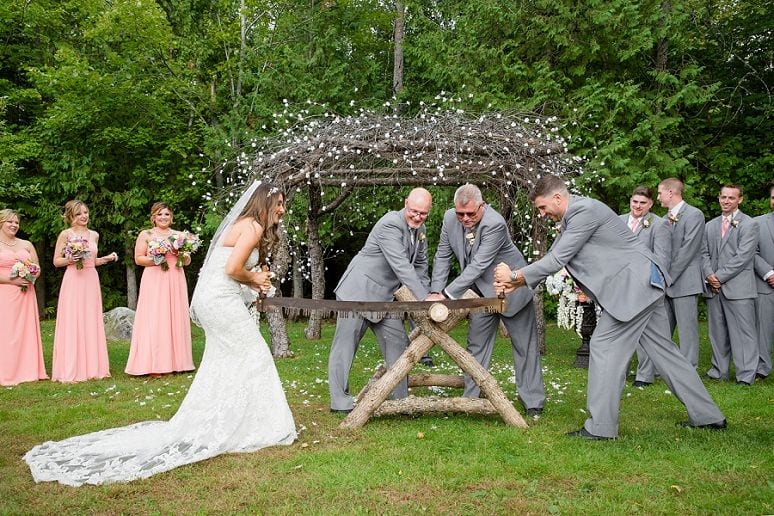
The intention of this tradition is to allow a space for team work for the couple shortly after getting married, and indicates a readiness to face their challenges together, as a family, and solve them. We think this is fascinating way to learn teamwork!
China – Games
Chinese weddings have a lot of traditions, but this one is really fun! This one includes games for all age groups, but is mainly played by the couple. These games are primarily a bunch of tests and challenges that the bridesmaids design to test their friend’s groom.
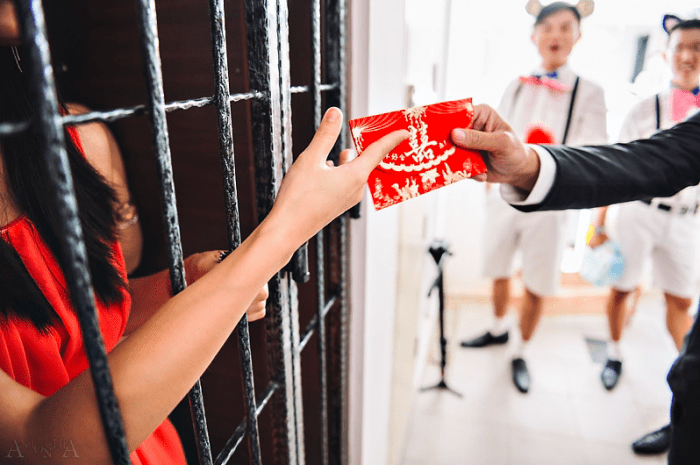
These games are a fun way to prove whether the husband is worthy of the bride or not. It usually includes a whole lot of laughter, because of the kind of tasks and questions asked in front of the entire wedding party.
French Polynesia – The Human Carpet
A tradition that, frankly, sounds a bit painful to us, but has it’s history, is that of the human carpet formation during weddings held in the Marquesas Islands of French Polynesia. And yes,t is exactly what it sounds like.
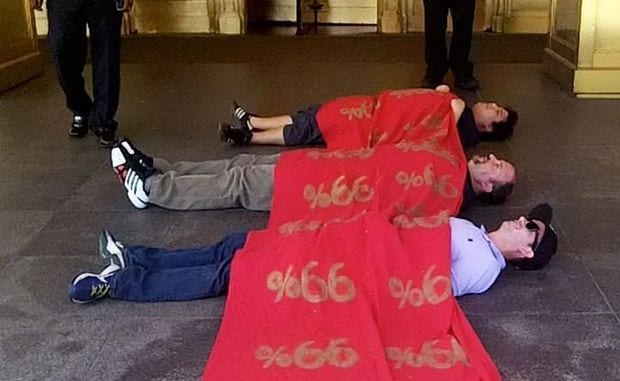
After the ceremony, the family and friends of the couple lay down on the floor to form a raised carpet of sorts on which the couple walks across the hall. This is a symbol of family and friends always being a support system for the couple.
India – Lost Ring
In an almost flirtatious tradition in India wedding ceremonies, the engagement rings of the bride and groom are dropped into a tub of milk covered with rose petals. This cute and lighthearted game’s goal is to see who finds the ring first.
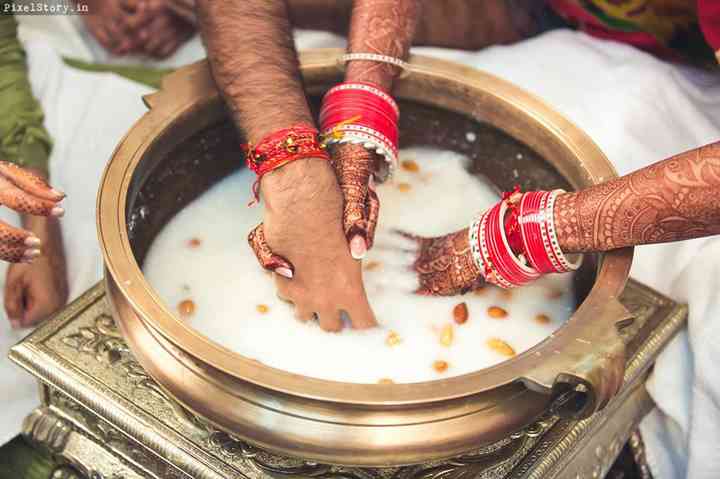
Whoever wins is said to be the one who “wears the pants” in the relationship, the headstrong one, and is mocked for being incredibly eager to get on with the wedding because of the speed and desperation with which they found the ring.
Russia – Wedding Photos
This is the last Russian tradition on our list. It’s specifically based in Moscow, Russia’s metropolitan capital, where couples in the city visit the Tomb of the Unknown Soldier on their wedding day, and have a mini photoshoot there as a mark of respect to the dead.
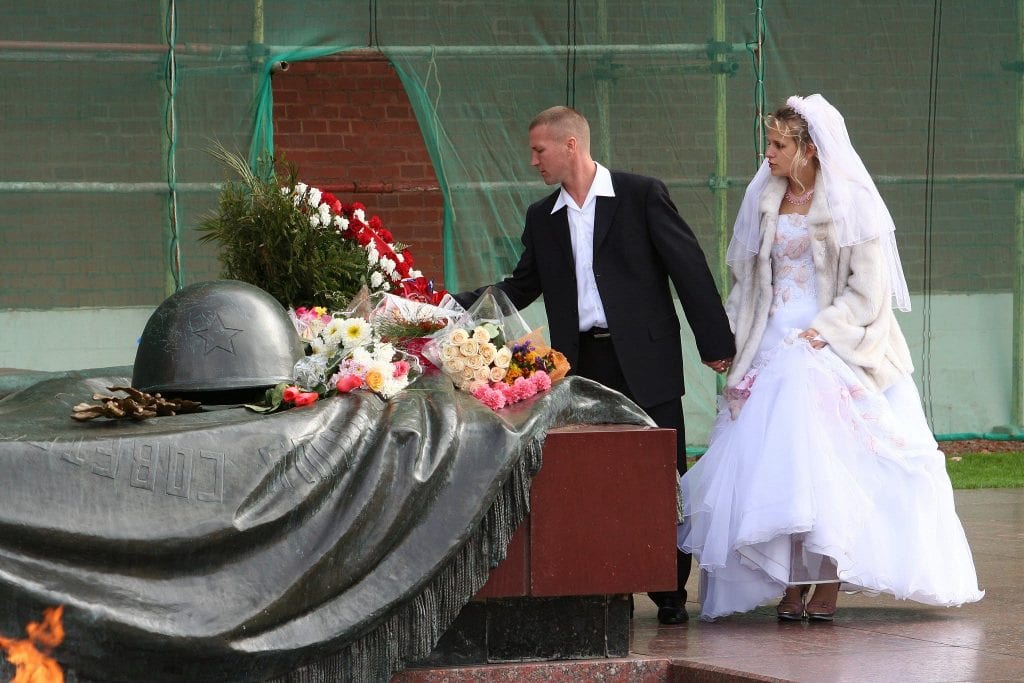
The couples also law down flowers at the tomb, located near the Kremlin, and while this isn’t popular throughout the country, several couples make travel plans to participate in the custom. Moscow wedding couples flock to the tomb in large numbers.
